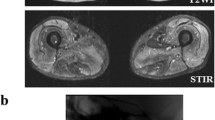Abstract
We report the clinical and bioptic findings for a 57-year-old woman with severe chloroquine-induced myopathy. Since 1989, she had been suffering from systemic lupus erythematosus (SLE) with renal involvement and undergone periods of treatment with azathioprine and cyclophosphamide. Additional therapy with chloroquine (CQ) was started because of arthralgia. At the same time, slightly increased creatine kinase (CK) levels were noted. Myositis was suspected, and the patient was treated with steroids. The CK increase persisted, however, and she developed progressive muscular weakness and muscular atrophy. Routine controls revealed markedly elevated CK levels of 1,700 U/l. The neurological and electrophysiological findings were not typical of myositis. Thus, muscle biopsy of the deltoid muscle was performed in order to exclude polymyositis or toxic myopathy. As it revealed chloroquine-induced myopathy, medication was stopped. Discriminating between primary SLE-induced affection of the musculoskeletal system and drug-induced side effects is important for appropriate treatment of SLE patients.

Similar content being viewed by others
References
Garton MJ, Isenberg DA (2000) Clinical features of lupus myositis versus idiopathic myositis: a review of 30 cases. Br J Rheum 36:1067–1074
Lim KL, Abduhl-Wahab R, Lowe J, Powell RJ (1994) Muscle biopsy abnormalities in systemic lupus erythematosus: correlation with clinical and laboratory parameters. Ann Rheum Dis 53:178–182
Richards AJ (1998) Hydroxychloroquine myopathy. J Rheumatol 25:1642–1643
Estes ML, Ewing-Wilson D, Chou SM et al (1987) Chloroquine Neuromyotoxicity. Am J Med 82:447–455
Satoh M, Miyazaki K, Minori T et al (1995) Changing autoantibodies with variable clinical manifestations in a patient with relapsing lupus erythematosus and polymyositis. Br J Rheumatol 34:915–919
Barber J, Butler RC, Davie MW, Sewery CA (2001) Hypoparathyroidism presenting as myopathy with raised creatine kinase. Rheumatology 40:1417–1418
Khaleeli AA, Griffith DG, Edwards RH (1983) The clinical presentation of hypothyroid myopathy and its relationship to abnormalities in structure and function of skeletal muscle. Clin Endocrinol 19:365–376
El Maghouri A, Birouk N, Zaim A, Slassi I, Yahyaoui M, Chkili T (1995) Syndrome de Fahr et dysparathyroidie. Trois observations. Presse Med 24:1301–1304
Von Moltke A (1997) Ausgedehnte Stammganglienverkalkung bei Morbus Fahr nach Schilddrüsenoperation 1949. Dtsch Med Wochenschr 122:1267
Vicale CT (1949) The diagnostic features of a muscular syndrome resulting from hypoparathyroidism, osteomalacia owing to renal tubular acidosis, and perhaps to related disorders of calcium metabolism. Trans Am Neurol Assoc 74:143–147
Ishikawa T, Saito M MH, Watanabe I (1995) Effect of hypocalcemia on muscle in disorder of calcium metabolism. Acta Paediatrica Japonica 37:367–369
Battistella PA, Pozzan GB, Rigon F, Zachello F (1991) Autoimmune hypoparathyrodism and hyper-CK-emia. Brain Dev 13:61
Van Offel J, De Gendt C, De Clerck L, Stevens WJ (2000) High bone mass and hypocalcaemic myopathy in a patient with idiopathic hypoparathyroidism. Clin Rheumatol 19:64–66
Berar-Yanay N, Weiner P, Magadle R (2001) Hypercalcemia in systemic lupus erythematosus. Clin Rheumatol 20:147–149
Avina-Zubieta JA, Johnson ES, Suarez-Almazor ME, Russell AS (1995) Incidence of myopathy treated with antimalarials. A report of three cases and review of the literature. Br J Rheumatol 34:166–170
Harel L, Mukamel H, Amir J, Straussberg R, Cohen A, Varsano I (1998) Colchicine induced myoneuropathy in childhood. Eur J Pediatr 157:853–855
Maltz HC, Balog DL, Cheigh JS (1999) Rhabdomyolysis associated with concomitant use of atorvastatin and cyclosporine. Ann Pharmacother 33:1176–1179
D'Cruz D (2000) Autoimmune diseases associated with drugs, chemicals and environmental factors. Toxicol Lett 112, 113:421–432
Bagnall AW (1957) The value of chloroquine in rheumatoid disease: a four year study of continuous therapy. Can Med Assoc J 77:182
Ratliff NB, Estes MI, Myles JL, Shirey EK, MacMahon JT (1987) Diagnosis of chloroquine cardiomyopathy by endomyocardial biopsy. N Engl J Med 316:191–193
Cubero GI, Reguero JJR, Ortega JMR (1993) Restrictive cardiomyopathy caused by chloroquine. Br Heart J 69:451–452
Tattevin P, Arondelle C, Margent P, Broucker De T (1999) Complications neuromusculaires du traitement de fond de maladies inflammatoires. Trois observations. Ann Med Interne 150:594–597
Wang C, Fortin PR, Li Y, Panaritis T, Gans M, Esdaile JM (1999) Discontinuation of antimalarial drugs in systemic lupus erythematosus. J Rheumatol 26:808–815
Malcangi G, Fraticelli P, Palmieri C, Cappelli M, Danieli MG (2000) Hydroxychloroquine-induced seizure in a patient with systemic lupus erythematosus. Rheumatol Int 20:31–33
Stein M, Bell MJ, Ang LC (2000) Hydroxychloroquine neuromyotoxicity. J Rheumatol 27:2927–2931
MacDonald RD, Engel AG (1970) Experimental chloroquine myopathy. J Neuropathol Exp Neurol 29:479–499
Neville HE, Maunder-Sewry CA, McDougall J, Sewill JR, Dubowitz V (1979) Chloroquine-induced cytosomes with curvilinear profiles in muscle. Muscle Nerve 2:376–381
Kumamoto T, Nagao SI, Sugihara R, Abe T, Ueyama H, Tsuda T (1998) Effect of chloroquine-induced myopathy on rat soleus muscle sarcoplasm and expression of clathrin. Muscle Nerve 21:665–668
Appenzeller S, Kobayashi E, Costallat L et al (2000) Magnetic resonance imaging in the evaluation of patients with aseptic meningoencephalitis and connective tissue disorders. Arq Neuropsiquiatr 58:45–51
Fraser DD, Frank JA, Dalakas M, Miller FW, Hicks JE, Plotz P (1991) Magnetic resonance imaging in the idiopathic inflammatory myopathies. J Rheumatol 18:1693–1700
Hilario M, Yamashita H, Lutti D, Len C, Terreri MT, Ledermann H (2000) Juvenile idiopathic inflammatory myopathies: the value of magnetic resonance imaging in the detection of muscle involvement. Sao Paulo Med J 118:35–40
Author information
Authors and Affiliations
Corresponding author
Rights and permissions
About this article
Cite this article
Richter, J.G., Becker, A., Ostendorf, B. et al. Differential diagnosis of high serum creatine kinase levels in systemic lupus erythematosus. Rheumatol Int 23, 319–323 (2003). https://doi.org/10.1007/s00296-003-0309-0
Received:
Accepted:
Published:
Issue Date:
DOI: https://doi.org/10.1007/s00296-003-0309-0



